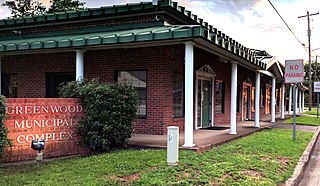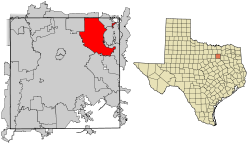
Fort Worth is a city in the U.S. state of Texas and the seat of Tarrant County, covering nearly 350 square miles (910 km2) into Denton, Johnson, Parker, and Wise counties. According to the 2024 United States census estimate, Fort Worth's population was 996,756 making it the fifth-most populous city in the state and the 12th-most populous in the United States. Fort Worth is the second-largest city in the Dallas–Fort Worth metroplex, which is the fourth-most populous metropolitan area in the United States and the most populous in Texas.

Rockwall County is a county in the U.S. state of Texas. At 149 square miles, Rockwall County has the smallest area of any Texas county. Per the 2020 Census, its population was 107,819. Its county seat is Rockwall. The county and city are named for a wall-like subterranean rock formation that runs throughout the county.

Ellis County is a county located in the U.S. state of Texas. As of 2020, its population was estimated to be 192,455. The county seat is Waxahachie. The county was founded in 1849 and organized the next year. It is named for Richard Ellis, president of the convention that produced the Texas Declaration of Independence. Ellis County is included in the Dallas–Fort Worth–Arlington metropolitan statistical area.

Dallas County is the second-most populous county in the U.S. state of Texas with a 2020 U.S. census count of 2,613,539, making it the ninth-most populous county in the country. Dallas County is included in the Dallas-Arlington-Fort Worth metropolitan statistical area—colloquially referred to as the Dallas–Fort Worth metroplex. Municipal expansion within Dallas County has blurred the geographic lines between cities and between neighboring counties.

Arlington is a city in Tarrant County, Texas, United States. It is part of the Mid-Cities region of the Dallas–Fort Worth–Arlington metropolitan statistical area, and is a principal city of the metropolis and region. The city had a population of 394,266 in 2020, making it the second-largest city in the county after Fort Worth and the third-largest city in the metropolitan area, after Dallas and Fort Worth. Arlington is the 50th-most populous city in the United States, the seventh-most populous city in the state of Texas, and the largest city in the state that is not a county seat.

Greenwood is a suburban town in southern Caddo Parish, which is located in the northwest corner of the U.S. state of Louisiana. With a population of 3,166 at the 2020 United States census, it is the third most populous incorporated municipality in Caddo Parish after Shreveport and Blanchard. Part of the Shreveport-Bossier City metropolitan statistical area, it is located 15 miles west of downtown Shreveport.

Lavon is a city in Collin County and has been one of the U.S. state of Texas's fastest-growing communities, with a 2000 census-tabulated population of 387 and 2020 tabulated population of 4,469.

Lamesa is a city in and the county seat of Dawson County, Texas, United States. The population was 8,674 at the 2020 census, down from 9,952 at the 2000 census. Located south of Lubbock on the Llano Estacado, Lamesa was founded in 1903. Most of its economy is based on cotton farming. The Preston E. Smith prison unit, named for the former governor of Texas, is located just outside Lamesa.

Waskom is a city in the U.S. state of Texas with a 2020 census-tabulated population of 1,910, down from 2,160 residents in 2010. It is located in Harrison County and lies approximately 19 miles (31 km) east of the county seat, Marshall, on U.S. 80 and Interstate 20. Waskom forms part of Greater Marshall, which is also included in the Longview–Marshall combined statistical area in the Ark-La-Tex region. To the east are the cities of Greenwood and Shreveport, Louisiana.

Caddo Mills is a rural city in Hunt County, Texas located at the western edge of Northeast Texas. The population was 1,495 at the 2020 census, up from 1,338 at the 2010 census.

Carrollton is a city in Dallas, Denton, and Collin counties in the U.S. state of Texas. As of the 2020 census, its population was 133,434, making it the 27th-most populous city in Texas.

Sachse is a city in Collin and Dallas counties in the U.S. state of Texas and is part of the DFW metroplex. A northeastern suburb of Dallas, the city population was 27,103, as of the 2020 census with an estimated population of 33,768 people today. Sachse is located off Texas State Highway 78 and President George Bush Turnpike and is approximately 1 mile (1.6 km) north of the Firewheel Town Center.

Wylie is a city and northeastern suburb of Dallas, that was once solely located in Collin County, but now extends into neighboring Dallas and Rockwall counties in the U.S. state of Texas. It is located on State Route 78 about 24 miles (39 km) northeast of central Dallas and centrally located between nearby Lavon Lake and Lake Ray Hubbard.

Mesquite is a city in the U.S. state of Texas, located in Dallas County with portions extending into Kaufman County. The population was 150,108 at the 2020 census, and making it the 22nd-most populous city in Texas. Mesquite is positioned at the crossroads of four major highways, making locations such as downtown Dallas, Lake Ray Hubbard, Dallas Love Field, and DFW International Airport accessible.

Rowlett is a city in Dallas and Rockwall Counties in Texas, United States, and an eastern suburb of Dallas. It is a growing, upscale community with nearly $1.5 billion in development in the Dallas–Fort Worth metroplex, located on Lake Ray Hubbard.

Longview is a city in, and county seat of, Gregg County, Texas, United States. Longview is located in East Texas, where Interstate 20 and U.S. highways 80 and 259 converge just north of the Sabine River. According to the 2020 U.S. census, the city had a population of 81,638. Longview is the principal city of the Longview metropolitan statistical area, comprising Gregg, Upshur, and Rusk counties. The population of the metropolitan area as of 2021 census estimates was 287,858.

Garland Independent School District (GISD) is a public school district with its headquarters in the Harris Hill Administration Building in Garland, Texas, United States. Garland ISD extends from the Dallas city limits, northeast to the county line and serves parts of the communities of Garland, Rowlett, and Sachse. Small portions of Dallas and Wylie are served by Garland ISD.
Dallas is the ninth-most populous city in the U.S. and third in Texas after Houston and San Antonio. At the 2010 U.S. census, Dallas had a population of 1,197,816. In July 2018, the population estimate of the city of Dallas was 1,345,076, an increase of 147,260 since the 2010 United States Census.

The Tyler metropolitan area, or Greater Tyler area centered on the city of Tyler, Texas, is one of the largest Texan metropolitan areas in East Texas. It had a combined population of 216,080 according to the 2010 U.S. census, and 233,479 in 2020. The Tyler metropolitan area encompasses all of Smith County.
Dallas–Fort Worth is the most populous metropolitan area of Texas, and the Southern United States. Having 7,637,387 residents at the 2020 U.S. census, the metropolitan statistical area has experienced positive growth trends since the former Dallas and Fort Worth metropolitan areas conurbated into the Metroplex. By the 2022 census estimates, its population grew to 7,943,685.






























